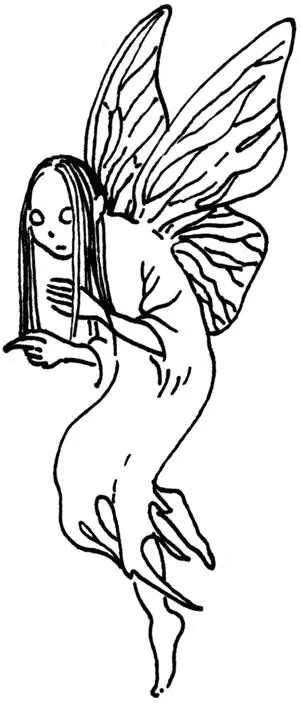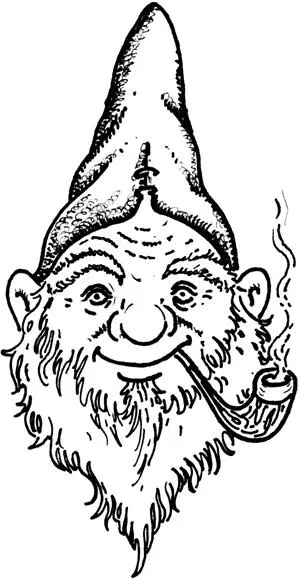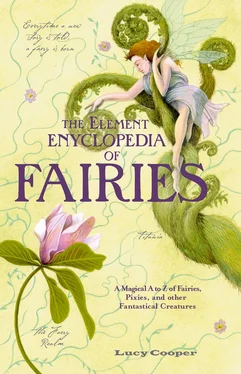A Loa, or Haitian Voodoo spirit, much to be feared.
A Scandinavian water creature manifesting as a beautiful white horse in folk tales. The comeliness of his appearance lures unsuspecting victims to jump onto his back and then, unable to escape, they are pitched into the nearest water to drown.
A mythical creature of the Lombardy region of northern Italy. The badalisc is a bad-tempered, gossipy monster with a large head and big mouth. Each year at Epiphany he is “captured,” with much drum-banging and a cast of traditional characters to accompany the procession. Afterward, he is led around the village and a speech is read out on his behalf in which the sins and misdemeanors of the locals are laid bare.
(Also badhbh .) A collective name for the three Irish goddesses of war— Nemen, Macha, and Morrigu—possessing magical powers to create confusion, stir fury, and bestow courage to aid their chosen victors in battle. In The Fairy-Faith in Celtic Countries by W. Y. Evans-Wentz(1911), the badb are described thus:
… this Irish war-goddess, the bodb or badb , considered of old to be one of the Tuatha De Danann , has survived to our own day in the fairy-lore of the chief Celtic countries. In Ireland the survival is best seen in the popular and still almost general belief among the peasantry that the fairies often exercise their magical powers under the form of royston-crows; and for this reason these birds are always greatly dreaded and avoided. The resting of one of them on a peasant’s cottage may signify many things, but often it means the death of one of the family or some great misfortune, the bird in such a case playing the part of a bean-sidhe [banshee].
See Badb .
In South American tradition a bakru is a tiny, childlike creature formed from wood and flesh, with a very large head. Protected by its wooden body, and with no brain of its own, it is a spirit to be feared for its ruthlessness. In Suriname there are several varieties of bakru , one of which is created by evil magicians to bring harm and even death to its victims.
(Or peat fairy.) Protectors of the peat bogs in Ireland, these little creatures are extremely unprepossessing in appearance, with bulgy, no-neck bodies supported on spindly legs, a froglike mouth full of long, pointy teeth and, due to their location, unsurprisingly covered in mud.
See Fomorians .
In Slavic folklore the bannik is the spirit of the banya , or bathhouse, an entity to be treated with the utmost respect and caution due to his violent tendencies if he and his demonic friends are angered or offended.

(Or Bean-Sidh .) An Irish omen of death in the form of a weeping, wailing spirit, described, in the seventeenth-century Memoirs of Lady Fanshawe , as “a woman in white … with red hair and pale and ghastly complexion: … to me her body looked more like a thick cloud than substance. I was so much frightened, that my hair stood on end, and my night clothes fell off …” Lady Fanshawe was recounting her experience while staying with an old Irish family.
Tales of the Scottish banshee depict the banshee as deformed. In Popular Tales of the West Highlands (4 vols, 1860–1862), J. F. Campbelldescribes an old mill that is haunted by a banshee:
She was sitting on a stone, quiet, and beautifully dressed in a green silk dress, the sleeves of which were curiously puffed from the wrists to the shoulder. Her long hair was yellow, like ripe corn; but on nearer view, she had no nose.
See also Bozaloshtsh , Caoineag , Caointeach , Cyhyraeth .
A beautiful but evil fairy in Scottish folklore, a succubus whose purpose is to seduce her victim and suck their blood until they die.

Mountain-dwelling, white-bearded gnomesof French and Swiss tradition, whose element is ice and snow. Their extremely large feet are advantageous for gliding over the snow-covered terrain. Their name is derived from barbe-glacée , meaning “frozen beard.”
A hellish black hound of the northern English moors, eyes afire, on the hunt for its next victim. Only those doomed to die can hear the howl of the barguest and their only escape is to cross running water, for the hound cannot follow.
Benevolent nature spirits in the folklore of the Tubetube and Wangawga people of Melanesia. These intensely shy beings dwell in trees and dread being seen by humans. However, they have been known to borrow canoes belonging to mortals, for it is said they are not able to build their own seagoing craft.
In one account, two bariaua borrowed a canoe one night to go fishing. Returning to shore in the early hours of dawn, they were surprised by an early-riser, a man named Burea. They disappeared immediately, leaving their catch of fish and their net in the canoe.
Burea shared the fish with the other villagers and hung the net up in the potama , or clubhouse.
The next morning the net had gone, claimed back by the bariaua , but the kindly spirits did not inflict any punishment upon Burea for eating their haul of fish.
Depicted as a top-hatted, formally dressed corpselike figure in the Haitian Voodoo tradition, Baron Samedi has great powers over life and death, and represents both the hedonism and enjoyment of life and the inevitability of death.
Basile, Giambattista (c.1575–1632)
Born in Naples, Giambattista Basile was an Italian soldier, poet, writer, and collector of fairy tales. He is best known for his collection of Neapolitan tales, La Cunto de la Cunti ( The Story of Stories ) (1634, 1636), also known as Il Pentamerone , a collection of 50 stories based on traditional Italian folk tales. It was published posthumously by his sister under the pseudonym Gian Alesio Abbatutis. It includes the earliest recorded versions of many tales that are still familiar to readers today, including “Puss in Boots,” “Rapunzel,” “Snow White,” “Beauty and the Beast,” and “Cinderella.”
Basile’s collection influenced later fairytale writers and collectors, including Charles Perraultin France and the brothers Grimmin Germany.
The curious phenomenon of a troop of fairies discovered bathing in the health-giving waters of Ilkley Wells in the north of England is recounted in the 1878 edition of the Folk-Lore Record. A local resident asks the villagers what kind of things these fairies were, and they usually maintain that they are active little beings and resemble the human form, that they are “lill folk, and always dressed in green, but so agile that no-one [can] ever come up to them.” The bathman, William Butterfield, who looks after the Wells, further describes how he came to open up the baths one morning and had great trouble with the door, until:
Читать дальше














